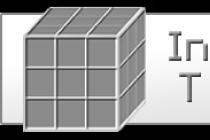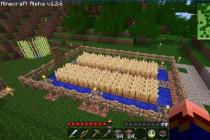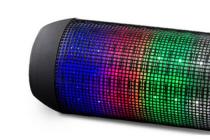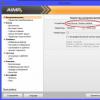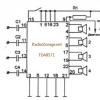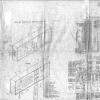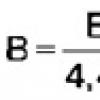Lens aperture - f number
If you regularly read our lessons, you already know how the maximum aperture value is indicated in the characteristics. So the aperture ratio of the lens is the f number, and to be precise, then f divided by one or another number. After all, f stands for focal length. And the aperture value is the number by which the set focal length is divided.

Aperture must be indicated in the characteristics of any lens. This does not necessarily mean separately sold optics. These words apply even to compact cameras with a built-in lens. Moreover, now the parameter "Aperture" or "Aperture" can be found even in the characteristics of flagship smartphones. Indeed, in the production of cameras built into them, more and more advanced lenses are used. As a result, the device receives high-aperture optics, and the pictures become very bright.

But enough words about the creation of optics. Let's approach lens aperture from the other side. Now we need to understand why buyers pay attention to this parameter at all. And everything turns out to be very simple. If the diaphragm is able to open very wide, then a lot of light enters the matrix. Some lenses provide f/1.4 aperture. With this parameter, you can use a shutter speed of 1/4000 second, while the matrix will have enough light.
Increased aperture favorably affects the quality of portrait photographs. The more the aperture opens, the smaller the zone of sharpness becomes. As a result, you can achieve a beautifully blurred background. This effect is also called the word "bokeh". That is why experienced photographers use fast lenses to shoot portraits. They leave all kinds of zoom optics for shooting landscapes.

Also, glasses with a good f-number are needed for evening photography. In low light, either a slow shutter speed or a wide aperture is required. Nobody will interfere with increasing the shutter speed, but this will not allow you to capture moving objects in the frame. Therefore, it is better to open the aperture to f / 1.8 or f / 1.4. But this method does not always work either. Indeed, with this value, the field of sharpness narrows, and sometimes this does not correspond to the photographer's idea.
Fast lens for Canon and Nikon
In stores, cameras with whale optics are sold in large quantities. And a rare buyer understands that the manufacturer puts a lens with an average, and sometimes even terrible aperture ratio, into the kit. This is especially true for optics with a wide range of focal lengths. Therefore, in various forums and specialized resources, people are recommended to purchase a “carcass”. This word refers to a kit in which there is only a camera. Well, then a fast lens is bought separately. As a result, a slightly larger amount is spent in this way than for a kit with whale optics, but the result will please you much more.

Unfortunately, not every lens sold in the store is fast. Be sure to look in the specifications for the aperture value. At 50mm focal length, f/1.8 aperture will be considered fast. The higher the focal length, the smaller the maximum aperture opening. Think of the lenses used by photographers working at football matches. They would give anything for f/2. But it is still technically impossible to achieve it.
Let's take a look at some good fast lenses that you can find in stores these days. At the same time, we are now interested in inexpensive optics for cameras from the two most famous manufacturers - Canon and Nikon.

Let's start with fast lenses for Canon, and here the Canon EF 50mm f1.8 II glass is very popular now. This is the second generation of this optics. As the name implies, the lens has a fixed 50mm focal length. This can be confusing for beginner photographers. But on the other hand, the aperture is able to open up to f / 1.8. Alas, the lens is not the best. Many buyers find fault with its body. But this should not be surprising, since nothing else can be expected from budget glass (you can buy it for 4,000 rubles).
More than four times more expensive is the Canon EF 50mm f1.4 USM. Sometimes even experienced professionals acquire such a lens. They note a very high aperture and beautiful bokeh obtained in the pictures.

If we talk about fast lenses for Nikon, there are also a lot of them, and mostly specimens with a fixed focal length have a high aperture value. For 5 thousand rubles, it is proposed to buy a Nikon 50mm f1.8D AF Nikkor.

This optic delivers the popular 50mm focal length. It is great for cameras with a crop factor of 1.5. But there are also problems with the body, the lens is extremely flimsy.
Nikon 24-85mm f2.8-4D IF AF Zoom-Nikkor looks like a very interesting solution. This is a zoom lens. At the minimum zoom, the aperture can open up to an acceptable f / 2.8 value. But as the focal length increases, the aperture deteriorates. This is the problem with any inexpensive zoom lens. Although this decision cannot be called a budget one, more than 24 thousand rubles are asked for glass in Russian stores.

Full-frame DSLR owners should be interested in the Nikon 24-70mm f2.8G ED AF-S Nikkor lens. This optic is similar to the previous one, only the range of focal lengths is slightly narrower. But the aperture here does not change when using the zoom! There are other improvements as well. But this lens costs a lot - 65 thousand rubles.
Results: lens aperture - what is it?
It's time to sum up our lesson: lens aperture - what is it and how to understand it correctly? If you are interested in the correct answer, then this is the degree of attenuation of the light flux passing through the lens. But most often the word "aperture" means the amount of aperture opening.

High aperture is needed to get bright photos with high speed exposure. Also, a wide-open aperture is needed to maximize the blurring of the background, which makes for beautiful portraits. Lenses with a fixed focal length have good aperture. If you are interested in fast optics with the ability to zoom, then get ready to spend a lot of money. And the larger the zoom is of interest, the larger the amount required. This is due to the complexity of manufacturing such lenses.

This concludes our lessons on the diaphragm. Visit our site regularly, then you will not miss the following lessons. In them, we will look at the camera in all details and find out which characteristics are the most important.
What is written on the lens?
Please look at this lens - what do the numbers on the lens barrel mean?
Aperture of a lens is the aperture value of a lens when it is fully open.
For the lens in the photo just above, the lens aperture is 2.6. And than less number, topics lens aperture more. Paradox?
There is no paradox here ... when we say MAXIMUM DIAPHRAGM, it means that it is completely open and we mean the size of the aperture hole, and not its designation with a number. And the number indicating the aperture at its maximum opening will be minimal because in reality it is the denominator of a natural fraction (if you notice, 1: 2.8 is written on the lens barrel - these two points are a mathematical division sign, often there is so little space on the frame, that the division sign and the unit are simply not written
Why is lens aperture important when choosing a camera?
When choosing a camera with a removable (=interchangeable) lens, you can buy a fast lens and replace the one you already have. But if you are going to buy a camera with a fixed lens (for example, a compact camera), it is very important to find a suitable model of a camera with a fast lens - with an aperture of no worse than 2.8. Because the more the aperture of the lens opens, the more freedom you will have, the freer you will feel in non-standard lighting conditions.
In addition, the depth of field depends on the aperture of the lens. In turn, depends on your photos.
Many compact cameras have a very limited choice of apertures, and as a result, a large depth of field. Moreover, some super-compact models of digital cameras and almost all cameras do not have smartphones and phones - in such cameras, instead of the classic diaphragm (an adjustable hole in the partition between the lens lenses), a special filter is used, the transparency of which is regulated by the camera electronics. With such a camera, it is generally impossible to influence the depth of field. I'm not going to say it's good or bad. It all depends on
If you don't want to "bother" with the camera settings and you like to just point the camera at the subject and press the shutter button - you won't even notice the difference. If you like to experiment a lot, shooting in different, often not ideal, lighting conditions, 2 or 3 apertures available can severely limit your options.
I thought I'd write the rest in about a month. But no matter how many times I started, I just couldn’t calmly sit down and continue the topic. Now there is some time to put the characteristics of optics, as they say, on the shelves, and the second part is in front of you. Let me remind you that in the previous article we talked about the focal length and its recalculation, taking into account the crop. Today we will consider in detail the aperture ratio and its derivatives - shutter speed and depth of field.
Aperture
After you have decided on the required focal length, aperture is the second most important lens parameter. What will she influence? First of all, for shutter speed - the higher the aperture, the lower the shutter speed, which means you can shoot in darker conditions without a tripod. The second is the blurring of the background, other things being equal, the higher the aperture ratio, the smaller the depth of field and the more the background is blurred. I dwelled on this issue in detail in the article ““, so I won’t especially repeat myself here, but I’ll tell you in a nutshell.
The aperture of a lens is essentially determined by how wide the aperture is opened. Labels such as Canon EF 50mm f/1.4 USM list the maximum aperture as f/1.4. With rare exceptions, Canon has a lens with an aperture of 1.2 and seems to have been preparing with a value of 1, all other lenses have a “narrower” aperture, such as 3.5 or 4 or even 5.6. The maximum values can be constant for high-quality optics (one number is indicated) or variable depending on the focal length for optics of a class below (numbers are indicated with a hyphen). The photo on the left was at f/2.2, which is not even possible with many professional L-series lenses.
The effect of aperture on shutter speed
I think now there should be no problems with determining the aperture value, so let's talk about why we need it in real conditions, and not in theory. A small aperture makes the lens lighter or faster, whichever you prefer, compared to a larger one. In other words, a lens with aperture of 2.8 is better for working at dusk or for shooting a dynamic football match than optics with aperture of 4. A slower shutter speed in the first case will allow you to get clear, bright handheld shots, because. with a wider aperture, more light will enter the matrix in the same time. And in the second, it will stop the moment of the game, because. the shutter speed will be very small and the camera will catch the fastest movement without blurring the players.

I'll use the photo above as an illustration. The shooting parameters were as follows - shutter speed 1/1000s, aperture 4.0. These values made it possible to obtain a clear photo of the athlete, although the speed upon landing was quite noticeable. But if it were darker, then the shutter speed would increase and the figure of the jumper would turn out to be smeared, and this is where faster optics would come in handy.
Lens aperture and background blur
I hope this is clear, now the second aspect is blurring the background. In short, if you want a beautiful background blur, take a fast lens. For photography of architecture, landscapes, still life and studio work, inexpensive kit lenses and L-series lenses with apertures of 4.0 are quite suitable. In these genres, all objects in the frame should have sharpness, and blurring the background rather interferes. But if you want to shoot portraits, then separating the model from the background becomes a very important task, and this is where wide aperture optics come to the rescue, because the wider the aperture is open, the more the background is blurred. Also, a shallow depth of field can be useful in macro photography.

For example, let's look at a photo of a lizard. The aperture value is 2.8, the background is blurred and the viewer's attention is focused on the reptile. Already at aperture 4.0, the blur is much less, which will make the photo flatter and distract from the main subject.
Optical stabilizer
Lenses for Canon and Nikon cameras can be equipped with Image Stabilizer. Referred to as IS for Canon and VR for Nikon. You can read more about why you need a stabilizer in my other one in the “exposure” section. Sony has a stabilizer built into the camera itself and, accordingly, choosing a lens is somewhat easier.
This digression appeared in an article about aperture ratio for a reason. If blurring the background is not important for you, but quite often there are shootings in low light, then the presence of a stabilizer allows you to save quite a lot on buying a lens. You can take a less fast lens, but with a stabilizer, while the shutter speeds at which you will get blurry photos will remain approximately the same. In addition, lenses with a smaller aperture are usually simpler in design, which can significantly reduce their weight, and this can sometimes be a big advantage.
To summarize the article, I will formulate a brief conclusion on the aperture ratio of lenses. The higher the lens aperture, the wider the range of possible lighting conditions and the more beautiful background blur you can get, the other side of the coin is, of course, the price, which grows along with the aperture.
We all know that fast lenses are good. Firstly, you can shoot in low light, without having to raise the ISO or slow down the shutter speed. Secondly, you can get an artistic effect on photos and videos - due to the shallow depth of field and beautiful background blur. Many of us have f/1.8 lenses, some f/1.4 or even f/1.2. We know that "one" is not the limit, we have heard about lenses with aperture of f / 0.95 (and some lucky ones have them at their disposal). There are rare f/0.8 models on the market. And what is the maximum aperture that the lens can theoretically have?
This topic is dedicated video by Matt Granger.
Matt says that just as there is a race for high ISOs now (and a little earlier - a race for megapixels), so in the 60s and 70s of the last century there was a race for high aperture. Here is a Zeiss 50mm f/0.7 lens that was made for NASA:
Legendary director Stanley Kubrick used this lens in 1975 to shoot a scene in the film Barry Lyndon lit entirely by candle flames.

And here is the f/0.33 lens. It was made in the 60s, again by Zeiss, and given the name "Super-Q-Gigantar 40mm f / 0.33", where Q is short for Quatsch, which in German means "Bullshit, nonsense, stupidity." Unofficially, he was teased "Frankenstein".

In fact, this lens has never worked, in fact it is a weight and size mock-up created for promotion and determining the reaction of the public.

But what can be the maximum aperture - theoretically?
Since the formula defines aperture as focal length divided by maximum aperture, it is theoretically possible to make a lens with a focal length of 35 mm and an aperture of 350 mm - please, you get an incredible aperture of f / 0.1.
The trouble is that "theoretically possible" and "practically realizable" - in this case, two things very far from each other. After all, we are talking about a lens with an aperture of 35 centimeters (that is, the diameter of the outer lens and frame will be even larger), which will also be very heavy. The depth of field will not even be calculated in millimeters, but in tiny fractions of millimeters, the rest of the areas will be blurred in the strongest way. It is difficult to think of why such a lens is needed in practice.
Matt Granger spoke with the developers of Zeiss, and they confirmed that, in principle, if you do not take into account issues of cost and practical benefits, such a lens can be made. But it will be prohibitively expensive.
- this is one of the main parameters that you should pay attention to when choosing a lens (along with ). The luminosity of the optical system shows the degree of attenuation of the light flux. In other words, the luminosity shows how much of the light flux the lens system of the objective is able to pass through.
The fact is that part of the light flux passing through the lens is scattered and reflected from the lenses, part of the light is absorbed by the material from which the lenses are made (glass, optical plastic). Therefore, the luminous flux is attenuated by these purely physical characteristics.
Another main parameter that determines lens aperture- the value of the maximum open relative hole . The more you can open the aperture (the smaller the aperture value set), the greater the maximum amount of light the lens can let through. So, a lens marked f1.8 (or 1:1.8) will be considered faster than a lens marked f2.8 (1:2.8).
Often, for ease of perception, the lens aperture is simply determined by the maximum value that allows you to set this lens. In fact, the aperture ratio is an internal characteristic of the lens design, and the relative aperture of the aperture performs only a part of the functions for determining the aperture ratio of the lens.
However, from a purely practical point of view, it is much easier to compare lenses by the maximum possible open aperture. Therefore, from now on, I will equate the concepts of "lens aperture" and "the maximum open aperture that the lens allows you to set."
 Thus, lens aperture can be expressed as the maximum aperture value. The lens aperture is always indicated in the technical specifications when describing the lens, and is also marked on the lens itself near the front lens. Therefore, when you see the name of the Canon 24-70 f2.8 lens, then f2.8 is the aperture value. This means that when shooting with this lens, you can open the aperture up to a maximum of 2.8. That is, you will not have the technical ability to shoot with an aperture of 2.0 or 1.8, etc.
Thus, lens aperture can be expressed as the maximum aperture value. The lens aperture is always indicated in the technical specifications when describing the lens, and is also marked on the lens itself near the front lens. Therefore, when you see the name of the Canon 24-70 f2.8 lens, then f2.8 is the aperture value. This means that when shooting with this lens, you can open the aperture up to a maximum of 2.8. That is, you will not have the technical ability to shoot with an aperture of 2.0 or 1.8, etc.
aperture Lenses are considered, when using which you can shoot at f1.2-f2.8 aperture values. Lenses with an aperture of f3.5-f6.3 are no longer considered fast, they are also called "dark", because they are able to transmit less light. Such top manufacturers of photo optics as Carl Zeiss and Leica produce lens models with even larger apertures - f0.7 and f0.95. The most common fast lenses among photographers are f1.4-f2.8 lenses.
 Lens aperture May be constant and variable. Lenses with a constant aperture allow you to open the aperture as much as possible to the same value. For example, the Canon 70-200 f4.0 lens allows you to set the aperture to 4.0, regardless of the focal length set. When shooting at focal lengths of 70mm, 135mm, and 200mm, you can take a picture with aperture 4.0. Prime lenses (with a fixed focal length) automatically have a constant aperture.
Lens aperture May be constant and variable. Lenses with a constant aperture allow you to open the aperture as much as possible to the same value. For example, the Canon 70-200 f4.0 lens allows you to set the aperture to 4.0, regardless of the focal length set. When shooting at focal lengths of 70mm, 135mm, and 200mm, you can take a picture with aperture 4.0. Prime lenses (with a fixed focal length) automatically have a constant aperture.
 There are zoomed variable aperture lenses, which depends on the set focal length. The longer the focal length is set, the worse the aperture parameter. For example, the Canon 18-135 mm F 3.5-5.6 lens allows you to open the aperture up to f3.5 when shooting with a focal length of 18 mm, but when shooting with a focal length of 135 mm, you can only open the maximum aperture up to f5.6. Typically, such lenses have a reduced cost and poorer optical quality.
There are zoomed variable aperture lenses, which depends on the set focal length. The longer the focal length is set, the worse the aperture parameter. For example, the Canon 18-135 mm F 3.5-5.6 lens allows you to open the aperture up to f3.5 when shooting with a focal length of 18 mm, but when shooting with a focal length of 135 mm, you can only open the maximum aperture up to f5.6. Typically, such lenses have a reduced cost and poorer optical quality.
What does it affect lens aperture? Why is it considered such an important characteristic and why are photographers willing to pay tens of thousands for fast optics? All the advantages of fast lenses are tied to the aperture value. Remember what the aperture affects when shooting: the amount of light passed through the lens and in the frame.
So, by buying a lens with a larger aperture, you will be able to open the aperture more. This means that you will be able to let in more light (it becomes possible to shoot in low light). Also, the more the aperture is opened, the smaller the depth of field in the frame is (the objects that are not in the focus area are more blurred). That is why f1.4-f2.8 lenses are considered good portrait lenses.
You may notice that manufacturers of photo optics produce a line of lenses with the same focal length, but different aperture ratios. Moreover, the greater the aperture ratio, the more expensive the lens costs, and the increase in cost is significant. For example, let's compare the prices of Canon lenses with a focal length of 50 mm. So, a 50 mm 1.8 lens costs 3,500-4,000 rubles, a 50 mm 1.4 lens costs about 13,500 rubles, and a 50 mm lens with aperture ratio of 1.2 is sold at a price of almost 48,000 rubles. Data are current as of February 2013.
As we found out, in most cases the larger the aperture of the lens, the better, because:
— you can shoot in the worst lighting conditions;
- you can shoot with a smaller depth of field.
On the other hand, you need to pay a lot of money for additional aperture. Therefore, when choosing a lens, weigh the pros and cons.
Choose your lens wisely and enjoy your shots!

